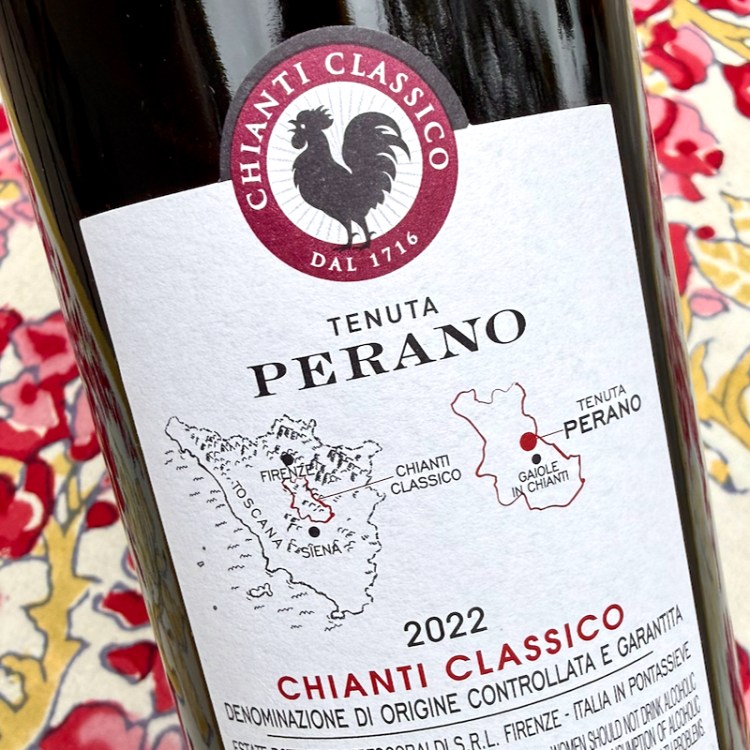Today we are tasting a Chianti Classico made by Marchesi Frescobaldi, a Tuscan family with 700 years of history in the region. Tenuta Perano blends that long family history with Chianti’s traditional grape, Sangiovese, made in Chianti’s most historic region. We received this wine as a tasting sample.
The People
The 30th generation of the Marchesi Frescobaldi family now manages the family’s nine estates in Tuscany, collectively referred to as Frescobaldi Toscana; they include: Castello Nipozzano, Castello Pomino, Tenuta Perano, Tenuta CastelGiocondo, Tenuta Castiglioni, Tenuta Ammiraglia, Tenuta Calimaia, Remole, and Gorgona. Attems, Tenuta Luce, Ornellaia, and Masseto are also Frescobaldi labels. All of the Tuscan estates operate independently with viticulture, fermentation, and cellaring decisions made by each team. This allows the wines from every estate to faithfully reflect their terroir.
Over a 700-year history, the family’s contributions would be too numerous to list, however, the recent press release linked above presents an abbreviated list, along with a concise summary of each label’s focus. Along with the more expected accomplishments of establishing Tuscany’s first gravity-fed winery at Castello Pomino in the mid-1800s, and the introduction of international varieties to Tuscan terroir, there is the unexpected project, Gorgona, that makes wine on an island penal colony 20 miles off the coast of Livorno. It’s a fascinating story of social responsibility resulting in wines that come with an astonishing price tag.
The Place
As far back as 1398 the name Chianti appeared in an official document with regard to wine made in today’s Chianti Classico region between Florence and Siena. A few years earlier, the Black Rooster (Gallo Nero) became the symbol of Chianti (today’s Chianti Classico) and remains so today.

In 1716 the Grand Duke of Tuscany Cosmo III recognized the rolling hills of this region for its quality wines and formalized the territorial boundaries for the production of Gallo Nero wines. By 1872 Barone Bettino Ricasoli, whose family had been linked to wine and Brolio Castle in Chianti since 1141, established the blend for what would become Chianti wine.
As demand for Chianti increased, it started being made outside the territory originally defined by Cosmo III. In order to preserve quality and protect their wines, 33 producers within the original boundaries joined together to form a consortium. That consortium, the first of its kind, called Consorzio Vino Chianti Classico today, continues to define and protect wines made in the original Chianti territory. After much administrative and legal wrangling in 1932 Classico was added to the Chianti name to identify wines made only in the territory originally defined by Cosmo III.
According to Italian wine law, Chianti DOC (Denominazione di Origine Controllata) was established in 1967 and Chianti Classico became a sub-zone of Chianti DOC. In 1984 Chianti was elevated to DOCG (Denominazione di Origine Controllata e Garantita) and Chianti Classico became a separate DOCG in 1996.
Also in 1996, the use of 100% Sangiovese was authorized, though not required, for Chianti Classico. Today’s regulations require at least 80% Sangiovese plus 10% of other allowed red grapes including some international varieties.
To further distinguish the best wines, in 2014 modifications to production standards for Chianti Classico were defined to create a level of wine above Reserva called Gran Selezione (GS). GS wines must be aged 6 months longer than Reserva wines and grapes must be sourced from winery’s own vineyards.
With the 2027 vintage, additional requirements will come into effect: the establishment of UGAs (unità geografiche aggiuntive, “additional geographical units”) and changes to the wine recipe requiring a higher percentage of Sangiovese and allowing only eight native varieties as blending partners. It’s a lot to absorb, but Italian Wine Central has all of the details and some interesting commentary about the changes.
The Wine

2022 Tenuta Perano Chianti Classico DOCG — nearly translucent ruby with aromas of tart red fruit, earth and dried brush. Flavors include ripe blackberries, dried tobacco leaf, raspberries and hints of cedar with bright acidity. Tannins are fine and drying in a barely medium body. 14% abv. SRP $32.99
Sangiovese is blended with 5% Merlot and fermented in stainless steel, then aged in oak barrels for 24 months and several months in bottle. It’s a delicious Sangiovese that tastes true to the variety and is very food friendly.
According to US importer, VINTUS, the 2022 vintage started with a cool, dry winter followed by an early, warm spring, then a hot summer which necessitated irrigation. Dry conditions reduced the vineyard yields, but quality was considered high.
According to the importer, in spite of the Frescobaldi family’s presence in Tuscany for 700 years, it wasn’t until 2014 that they purchased an estate in the original territory identified as Chianti Classico by Cosmo III in 1716. Tenuta Perano is home to 128 acres (52 hectares) of vines planted in a natural, hilly amphitheater. The steep slopes reach an elevation of 1640 feet above sea level and have an optimal exposure. Tenuta Perano is located in the Gaiole sub-zone of Chianti Classico.
Thanks to Colangelo & Partners for organizing our tasting.
Cheers!
I didn’t know the Frescobaldi’s had so many properties! And what a history! The wine sounds lovely!